An Individual Can Implement His/Her Own Aid Project in the Internet
Age: Old-fashioned aid funds such as Overseas Direct Aids between
governments have often failed to trickle down to the remote corners of the
world like the Himalayan highlands of Nepal. You can extend your personal
assistance directly to the people with whom you establish and maintain
direct personal contact in all corners of Asia. In the picture to the
left, the equipment installation team is receiving traditional silk scarf
in appreciation of the work done.
Nature of the Project and the Sociocultural Environment
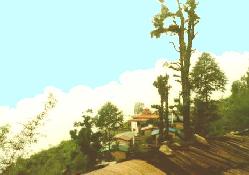 In the valley near the top of the range nestle two modest Buddhist
monasteries, Tashi Choling Gompa (picture to the right) and Pema Choling
Gompa, and they together serve the inhabitants of 7-8 neighboring villages
as the centers of their religious and social life. Both temples, however,
had been lighted until recently only by smothering little kerosine lamps,
which were still an expensive luxury due to the high cost of fuel when
"portered" up all the way from Kathmandu.
In the valley near the top of the range nestle two modest Buddhist
monasteries, Tashi Choling Gompa (picture to the right) and Pema Choling
Gompa, and they together serve the inhabitants of 7-8 neighboring villages
as the centers of their religious and social life. Both temples, however,
had been lighted until recently only by smothering little kerosine lamps,
which were still an expensive luxury due to the high cost of fuel when
"portered" up all the way from Kathmandu.
Like kerosine, all other consumer goods brought in from outside remained
costly to the cash-stripped monasteries even though their operating
expenses have always been provided for by the faithful villagers. If you
are to visit these people, you will first drive quite a distance until you
hit the narrow mountain pass. And then on, only several hours of hard work
trekking the hills will take you to these temples.
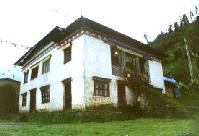 The next two pictures are the close shots of Pema Choling Gompa. To the
left is the front view of the building, and the solar panels are shown
installed on the roof of the pagoda (right below) sitting on top of the
building.
The next two pictures are the close shots of Pema Choling Gompa. To the
left is the front view of the building, and the solar panels are shown
installed on the roof of the pagoda (right below) sitting on top of the
building.
Environment-Friendly Solar Energy Can Do a Lot in a Country Like
Nepal
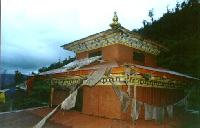 First of all, it now provides electric lighting systems to these two
monasteries. To properly understand its significance, we must first
realize that most of us in today's Japan are no longer able to feel what
it is really like to live without electricity. In addition to not just
having no electricity, no gas, no running water, etc., it also means that
we don't have the amenities now taken for granted such as telephone, radio
and television. In such an environment, therefore, people living in
mountainous northern regions of Nepal use their Buddhist monasteries as
the multiple-function centers of their daily life.
First of all, it now provides electric lighting systems to these two
monasteries. To properly understand its significance, we must first
realize that most of us in today's Japan are no longer able to feel what
it is really like to live without electricity. In addition to not just
having no electricity, no gas, no running water, etc., it also means that
we don't have the amenities now taken for granted such as telephone, radio
and television. In such an environment, therefore, people living in
mountainous northern regions of Nepal use their Buddhist monasteries as
the multiple-function centers of their daily life.
Lotus Energy Team at Work
On July 9, 1998, two teams of installers left Kathmandu Valley to
Malamchipul Bazar where they split to proceed toward both Tashi Choling
and Pema Choling Monasteries in the Helambu region of Nepal. Both
monasteries are a one-day uphill trek (for acclimatized Nepalese) from
Melamchipul Bazar which in turn is one day's drive out of the valley.
The installation took over 7 days at Tashi Choling and 5 days at Pema
Choling gompas, including the days spent on travelling. (Photos by
courtesy of Lotus
Energy Pvt. Ltd., Kathmandu, Nepal)
|
In addition to being the center of spiritual life, these temples also
serve as the community centers for the villagers who flock together on
various religious festivals and services held throughout the year. They
also function as the sole community school for both adults and children
like the Terakoyas (temple classes) used to function in Japan before the
modern times. For these reasons, therefore, the introduction of solar
energy lighting systems to the monasteries is bound to give fresh impetus
to new ways of doing things altering, hopefully all for the better, the
life and daily activities of the people in the Helambu region.
Looking at What Has Happened to the monasteries after
Installation
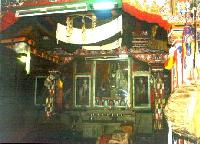
(1) Pema Choling Gompa
Now, let us look at some of the pictures sent us recently depicting the
changes brought about to different rooms and facilities of the monastery
as a result of solar energy electrification. The first two pictures are
the main shrine assembly hall with statues lighted in the evening hours.
We had asked the Lotus Energy people to take both "before" and "after"
pictures, but the shots taken before installation failed due to lack of
light, further illustrating the point.
 The short-term objective of this project is to lighten up the monasteries,
enable more effective and safe conduct of religious and educational
services so as to encourage greater participation in these and other civic
activities by the people of the area's villages. As already said, most
rooms of the monasteries are poorly ventilated due to cold climate making
it inevitably hazardous to health to burn wood or kerosine for lighting
purposes. Solar energy electrification will eliminate this, while also
contributing to the reduction of forest destruction in this region where
regrowth is a very difficult process. Also, it is noted from the long-term
standpoint that successful Nepal projects will enhance the feasibility of
similar projects elsewhere across the Himalayan highland communities such
as Bhutan, northern India, and Tibet.
The short-term objective of this project is to lighten up the monasteries,
enable more effective and safe conduct of religious and educational
services so as to encourage greater participation in these and other civic
activities by the people of the area's villages. As already said, most
rooms of the monasteries are poorly ventilated due to cold climate making
it inevitably hazardous to health to burn wood or kerosine for lighting
purposes. Solar energy electrification will eliminate this, while also
contributing to the reduction of forest destruction in this region where
regrowth is a very difficult process. Also, it is noted from the long-term
standpoint that successful Nepal projects will enhance the feasibility of
similar projects elsewhere across the Himalayan highland communities such
as Bhutan, northern India, and Tibet.
Besides, since these monasteries do occupy a central role in providing
important centers of the everyday life in the Himalayan communities, the
future possibility of powering up these solar facilities to enable them to
have direct access to the Internet will be a truly welcome occasion for
deepening not only the regional unity and cooperation, but also
contributing to the cause of global citizenship.
Thus, the utilization and wider application of the renewable energy
technology in the Himalayan countries promise to achieve the dual goal of
improving human health and quality of life on the one hand, and enhance
the educational and social opportunities without endangering the region's
delicate natural environment.
Tashi Choling Gompa
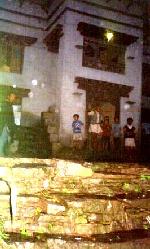 The picture to the right shows the front entrance of Tashi Choling Gompa
as it is illuminated by an overhead electric lighting fixture. In spite of
some delay due to the start of the monsoon season, the installation works
and the post-installation system checkups at both gompas were completed by
the middle of July.
The picture to the right shows the front entrance of Tashi Choling Gompa
as it is illuminated by an overhead electric lighting fixture. In spite of
some delay due to the start of the monsoon season, the installation works
and the post-installation system checkups at both gompas were completed by
the middle of July.
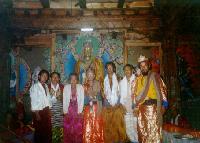 The picture to the right was taken at the gathering of the Lamas and the
local people in celebration of the completion of the gompa's
electrification. The local communities are fully aware of the
opportunities of improving the quality of their community life as a
result. According to a preliminary report filed by Lotus Energy Co., "the
monastery officials were extremely happy to have received this kind of
meaningful help for their community's religious activities. Both gompas
were happy that they would not be able to continue pujas into the night
and felt that the presence of such lighting systems would certainly
increase community participation and use of the gompas."
The picture to the right was taken at the gathering of the Lamas and the
local people in celebration of the completion of the gompa's
electrification. The local communities are fully aware of the
opportunities of improving the quality of their community life as a
result. According to a preliminary report filed by Lotus Energy Co., "the
monastery officials were extremely happy to have received this kind of
meaningful help for their community's religious activities. Both gompas
were happy that they would not be able to continue pujas into the night
and felt that the presence of such lighting systems would certainly
increase community participation and use of the gompas."
"Expenses for kerosene will be eliminated now and they hope to use the
savings for other purposes including expanding the system in the future if
required. At Pema Choling, the wall paintings will no longer be subjected
to the blackening from fumes of the small kerosene lamps and neither will
the Lamas and community smell the fumes any longer."
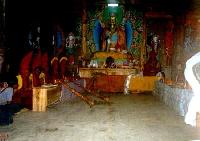
The last three pictures were taken at Tashi Choling on the specially
planned formal "puja" dedication in celebration of the coming of the
solar energy lighting system. To the right is a picture of the main
assembly hall with statues glistening under faint blue solar light. Such
services have always performed in the dark interior of the hall, but now
people can see everything from the Buddhas on down to every decorative
details of the interior and, of course, the presiding Lamas.
Exactly the same thing is beginning to happen to the educational
environment at the temple. The elimination of darkness and fumes will help
the local youngsters learn how to read and write without fear of impairing
eyesight.
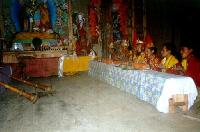 To the left is the scene of the dedication service. The Choling's high
Lama and his followers are at the right chanting sutra while the Choling
Long Dung Chen musical horns trumpet religious music.
To the left is the scene of the dedication service. The Choling's high
Lama and his followers are at the right chanting sutra while the Choling
Long Dung Chen musical horns trumpet religious music.
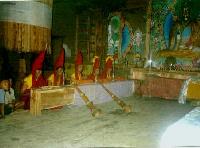 Numerous Tibetan Buddhist monasteries like this are scattered across the
foothills of the Himalayas from Tibet, across the entire range through
Nepal, Bhutan, and the northern sections of India, crisscrossing modern
national boundaries in peaceful cohabitation with other religions and
cultures.
Numerous Tibetan Buddhist monasteries like this are scattered across the
foothills of the Himalayas from Tibet, across the entire range through
Nepal, Bhutan, and the northern sections of India, crisscrossing modern
national boundaries in peaceful cohabitation with other religions and
cultures.
The participation by Mr. N. Tamura in this Nepal project of the Virtual
Foundation USA/Japan marks the long awaited beginning of a new Internet
philanthropy in Asia, which is based on the premise that the donors come
in and maintain direct contact and communication with the beneficiaries.
This will ensure not only the effectiveness and success of the projects
they get involved, but also promise the growth and deepening of mutual
understanding and respect amongst all peoples of the world as we move into
the 21st century.
Club officers at Chenango Forks were intrigued by the idea of doing
something to address world problems as well as debating about
them. Members of the Economic and Social Council at the conference will
debate and then vote, choosing from Virtual Foundation projects under $1000
which are currently unfunded. They will then present their decision to the
entire conference during the closing plenary session.
There are five committees at the conference: Economic and Social Council,
Security Council, International Court of Justice, and Legal and Political
Committee. Over 100 students from 8 schools in the Central New York
State region are planning to attend.
Chenango Forks Model UN sponsorship of an entire Virtual Foundation project
is made possible with a partial matching grant from the Open Society
Institute.
The trees are part of a stand of more than 21,000 acres of trees which had been
planted in a park near Beijing.
Financial difficulties had prevented the trees from getting care they needed.
To encourage the trees to grow quickly and become healthy, the Friends of
Nature in Beijing decided to recruit volunteers to tend the trees.
The group knew that there were schoolchildren interested in volunteering,
but they needed to buy tools. So they worked through a local partner to
place a proposal on the Virtual Foundation.
Esther Schmidt, a long-time volunteer tree planter in New York City,
funded this proposal, named "Adopt Trees". She is now exchanging
correspondence with the project organizers, and has received news
clippings and photographs. One of the photographs (above) shows children
working on the trees with the new tools.

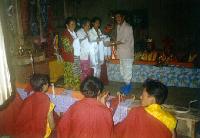 An Individual Can Implement His/Her Own Aid Project in the Internet
Age: Old-fashioned aid funds such as Overseas Direct Aids between
governments have often failed to trickle down to the remote corners of the
world like the Himalayan highlands of Nepal. You can extend your personal
assistance directly to the people with whom you establish and maintain
direct personal contact in all corners of Asia. In the picture to the
left, the equipment installation team is receiving traditional silk scarf
in appreciation of the work done.
An Individual Can Implement His/Her Own Aid Project in the Internet
Age: Old-fashioned aid funds such as Overseas Direct Aids between
governments have often failed to trickle down to the remote corners of the
world like the Himalayan highlands of Nepal. You can extend your personal
assistance directly to the people with whom you establish and maintain
direct personal contact in all corners of Asia. In the picture to the
left, the equipment installation team is receiving traditional silk scarf
in appreciation of the work done.
 In the valley near the top of the range nestle two modest Buddhist
monasteries, Tashi Choling Gompa (picture to the right) and Pema Choling
Gompa, and they together serve the inhabitants of 7-8 neighboring villages
as the centers of their religious and social life. Both temples, however,
had been lighted until recently only by smothering little kerosine lamps,
which were still an expensive luxury due to the high cost of fuel when
"portered" up all the way from Kathmandu.
In the valley near the top of the range nestle two modest Buddhist
monasteries, Tashi Choling Gompa (picture to the right) and Pema Choling
Gompa, and they together serve the inhabitants of 7-8 neighboring villages
as the centers of their religious and social life. Both temples, however,
had been lighted until recently only by smothering little kerosine lamps,
which were still an expensive luxury due to the high cost of fuel when
"portered" up all the way from Kathmandu.
 The next two pictures are the close shots of Pema Choling Gompa. To the
left is the front view of the building, and the solar panels are shown
installed on the roof of the pagoda (right below) sitting on top of the
building.
The next two pictures are the close shots of Pema Choling Gompa. To the
left is the front view of the building, and the solar panels are shown
installed on the roof of the pagoda (right below) sitting on top of the
building.
 First of all, it now provides electric lighting systems to these two
monasteries. To properly understand its significance, we must first
realize that most of us in today's Japan are no longer able to feel what
it is really like to live without electricity. In addition to not just
having no electricity, no gas, no running water, etc., it also means that
we don't have the amenities now taken for granted such as telephone, radio
and television. In such an environment, therefore, people living in
mountainous northern regions of Nepal use their Buddhist monasteries as
the multiple-function centers of their daily life.
First of all, it now provides electric lighting systems to these two
monasteries. To properly understand its significance, we must first
realize that most of us in today's Japan are no longer able to feel what
it is really like to live without electricity. In addition to not just
having no electricity, no gas, no running water, etc., it also means that
we don't have the amenities now taken for granted such as telephone, radio
and television. In such an environment, therefore, people living in
mountainous northern regions of Nepal use their Buddhist monasteries as
the multiple-function centers of their daily life. 
 The short-term objective of this project is to lighten up the monasteries,
enable more effective and safe conduct of religious and educational
services so as to encourage greater participation in these and other civic
activities by the people of the area's villages. As already said, most
rooms of the monasteries are poorly ventilated due to cold climate making
it inevitably hazardous to health to burn wood or kerosine for lighting
purposes. Solar energy electrification will eliminate this, while also
contributing to the reduction of forest destruction in this region where
regrowth is a very difficult process. Also, it is noted from the long-term
standpoint that successful Nepal projects will enhance the feasibility of
similar projects elsewhere across the Himalayan highland communities such
as Bhutan, northern India, and Tibet.
The short-term objective of this project is to lighten up the monasteries,
enable more effective and safe conduct of religious and educational
services so as to encourage greater participation in these and other civic
activities by the people of the area's villages. As already said, most
rooms of the monasteries are poorly ventilated due to cold climate making
it inevitably hazardous to health to burn wood or kerosine for lighting
purposes. Solar energy electrification will eliminate this, while also
contributing to the reduction of forest destruction in this region where
regrowth is a very difficult process. Also, it is noted from the long-term
standpoint that successful Nepal projects will enhance the feasibility of
similar projects elsewhere across the Himalayan highland communities such
as Bhutan, northern India, and Tibet.
 The picture to the right shows the front entrance of Tashi Choling Gompa
as it is illuminated by an overhead electric lighting fixture. In spite of
some delay due to the start of the monsoon season, the installation works
and the post-installation system checkups at both gompas were completed by
the middle of July.
The picture to the right shows the front entrance of Tashi Choling Gompa
as it is illuminated by an overhead electric lighting fixture. In spite of
some delay due to the start of the monsoon season, the installation works
and the post-installation system checkups at both gompas were completed by
the middle of July.
 The picture to the right was taken at the gathering of the Lamas and the
local people in celebration of the completion of the gompa's
electrification. The local communities are fully aware of the
opportunities of improving the quality of their community life as a
result. According to a preliminary report filed by Lotus Energy Co., "the
monastery officials were extremely happy to have received this kind of
meaningful help for their community's religious activities. Both gompas
were happy that they would not be able to continue pujas into the night
and felt that the presence of such lighting systems would certainly
increase community participation and use of the gompas."
The picture to the right was taken at the gathering of the Lamas and the
local people in celebration of the completion of the gompa's
electrification. The local communities are fully aware of the
opportunities of improving the quality of their community life as a
result. According to a preliminary report filed by Lotus Energy Co., "the
monastery officials were extremely happy to have received this kind of
meaningful help for their community's religious activities. Both gompas
were happy that they would not be able to continue pujas into the night
and felt that the presence of such lighting systems would certainly
increase community participation and use of the gompas."

 To the left is the scene of the dedication service. The Choling's high
Lama and his followers are at the right chanting sutra while the Choling
Long Dung Chen musical horns trumpet religious music.
To the left is the scene of the dedication service. The Choling's high
Lama and his followers are at the right chanting sutra while the Choling
Long Dung Chen musical horns trumpet religious music.
 Numerous Tibetan Buddhist monasteries like this are scattered across the
foothills of the Himalayas from Tibet, across the entire range through
Nepal, Bhutan, and the northern sections of India, crisscrossing modern
national boundaries in peaceful cohabitation with other religions and
cultures.
Numerous Tibetan Buddhist monasteries like this are scattered across the
foothills of the Himalayas from Tibet, across the entire range through
Nepal, Bhutan, and the northern sections of India, crisscrossing modern
national boundaries in peaceful cohabitation with other religions and
cultures.
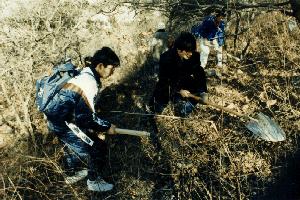 "I will care about this tree just as my parents care about me." stated
Zhou Xiaolu, a student of Kexing Experiment Middle School. She is
one of the volunteers from two colleges and three middle schools who are now
tending trees with tools bought by a Virtual Foundation grant.
"I will care about this tree just as my parents care about me." stated
Zhou Xiaolu, a student of Kexing Experiment Middle School. She is
one of the volunteers from two colleges and three middle schools who are now
tending trees with tools bought by a Virtual Foundation grant.